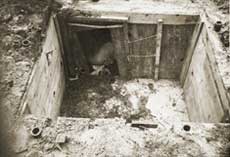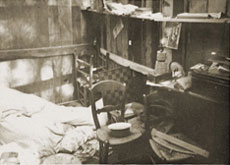View of the bunker that served as a hiding place for Dutch Jews in the Eibergen region in 1942-1943. The bunker was discovered by the Germans one day before this photograph was taken. The bunker was, in actuality, a prefabricated hut that was ordered by two Jewish brothers, Abraham and Herman Maas from Eibergen. It was delivered in sections to a site in the Hoones Forest outside Eibergen. The Maas brothers got permission from the manager of the privately-owned forest to build a subterranean hiding place for themselves. Two sympathetic non-Jews conveyed the materials, dug the hole and assembled the shelter, which had two rooms and a crude stove. Initially, only the brothers hid there, but as times grew more desperate, 23 Jews were concealed in the bunker. On March 27, 1943, a Dutch informer led Germans to the site. All 23 were arrested and sent to Westerbork. From there they were deported to Sobibor and killed. After the war the informer was identified as E. Heijink and tried as a collaborator. The photographer was a Dutchman, who was ordered to take pictures of the bunker the day after the Jews were captured. He made an extra set of prints, which he kept secretly, and made available to resisters and surviving Jews after the liberation. The policeman posed inside the bunker in order to better convey its size.
|

